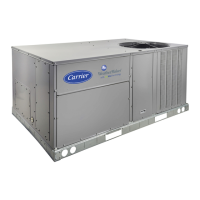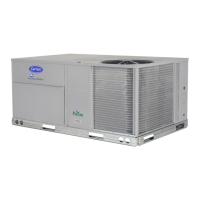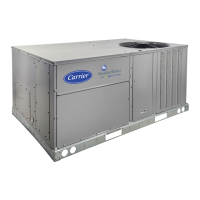2
Lubrication . . . . . . . . . . . . . . . . . . . . . . . . . . . . . . . . 139
Evaporator Fan Performance Adjustment . . . . . . 139
Evaporator Fan Coupling Assembly . . . . . . . . . . . 140
Evaporator Fan Service and Replacement . . . . . . 141
Belt Tension Adjustment . . . . . . . . . . . . . . . . . . . . 141
Evaporator-Fan Motor Replacement . . . . . . . . . . . 141
Condenser-Fan Adjustment . . . . . . . . . . . . . . . . . . 141
Four-Inch Filter Replacement . . . . . . . . . . . . . . . . . 141
Power Failure . . . . . . . . . . . . . . . . . . . . . . . . . . . . . . 142
Refrigerant Charge . . . . . . . . . . . . . . . . . . . . . . . . . 142
Thermostatic Expansion Valve (TXV) . . . . . . . . . . 142
Gas Valve Adjustment . . . . . . . . . . . . . . . . . . . . . . . 149
Main Burners . . . . . . . . . . . . . . . . . . . . . . . . . . . . . . 149
Filter Drier . . . . . . . . . . . . . . . . . . . . . . . . . . . . . . . . 149
Replacement Parts . . . . . . . . . . . . . . . . . . . . . . . . . 149
APPENDIX A — LOCAL DISPLAY TABLES . . . . . . . .150
APPENDIX B — CCN TABLES . . . . . . . . . . . . . . . . . . .161
APPENDIX C — VFD INFORMATION. . . . . . . . . . . . . .178
APPENDIX D — MODE SELECTION PROCESS. . . . . 186
APPENDIX E — UPC OPEN CONTROLLER . . . . . . . . 187
APPENDIX F — OPTIONAL FACTORY-INSTALLED
LOW AMBIENT MOTORMASTER V CONTROL. . .196
APPENDIX G — OPTIONAL GREENSPEED/LOW
AMBIENT CONTROL . . . . . . . . . . . . . . . . . . . . . . . . .206
INDEX . . . . . . . . . . . . . . . . . . . . . . . . . . . . . . . . . . . . . . . . 222
CONTROLS SETPOINT AND
CONFIGURATION LOG . . . . . . . . . . . . . . . . . . . . .223
UNIT START-UP CHECKLIST . . . . . . . . . . . . . . . . . . .CL-1
SAFETY CONSIDERATIONS
Installation and servicing of air-conditioning equipment can be
hazardous due to system pressure and electrical components.
Only trained and qualified service personnel should install,
repair, or service air-conditioning equipment.
Untrained personnel can perform basic maintenance functions
of cleaning coils and filters and replacing filters. All other
operations should be performed by trained service personnel.
When working on air-conditioning equipment, observe
precautions in the literature, tags and labels attached to the
unit, and other safety precautions that may apply.
Follow all safety codes, including ANSI (American National
Standards Institute) Z223.1. Wear safety glasses and work
gloves. Use quenching cloth for unbrazing operations. Have
fire extinguisher available for all brazing operations.
It is important to recognize safety information. This is the
safety-alert symbol . When you see this symbol on the unit
and in instructions or manuals, be alert to the potential for
personal injury.
Understand the signal words DANGER, WARNING,
CAUTION, and NOTE. These words are used with the safety-
alert symbol. DANGER identifies the most serious hazards
which will result in severe personal injury or death.
WARNING signifies hazards which could result in personal
injury or death. CAUTION is used to identify unsafe practices,
which may result in minor personal injury or product and
property damage. NOTE is used to highlight suggestions
which will result in enhanced installation, reliability, or
operation.
WARNING
Before performing service or maintenance operation on
unit turn off and lock off main power switch to unit. Electri-
cal shock can cause personal injury and death. Shut off all
power to this equipment during installation and service.
The unit may have an internal non-fused disconnect or a
field-installed disconnect. Note that the unit may also be
equipped with a convenience outlet, that this outlet is
wired to the line side of the unit-mounted disconnect
and will remain hot when the disconnect in the unit is
off. There is a separate fuse/ disconnect for the conve-
nience outlet.
CAUTION
DO NOT re-use compressor oil or any oil that has been ex-
posed to the atmosphere. Dispose of oil per local codes and
regulations. DO NOT leave refrigerant system open to air
any longer than the actual time required to service the
equipment. Seal circuits being serviced and charge with dry
nitrogen to prevent oil contamination when timely repairs
cannot be completed. Failure to follow these procedures
may result in damage to equipment.
WARNING
DO NOT USE TORCH to remove any component. System
contains oil and refrigerant under pressure.
To remove a component, wear protective gloves and gog-
gles and proceed as follows:
a. Shut off electrical power to unit.
b. Recover refrigerant to relieve all pressure from system
using both high-pressure and low pressure ports.
c. Traces of vapor should be displaced with nitrogen and
the work area should be well ventilated. Refrigerant in
contact with an open flame produces toxic gases.
d. Cut component connection tubing with tubing cutter and
remove component from unit. Use a pan to catch any oil
that may come out of the lines and as a gage for how
much oil to add to the system.
e. Carefully un-sweat remaining tubing stubs when neces-
sary. Oil can ignite when exposed to torch flame.
Failure to follow these procedures may result in personal
injury or death.
WARNING
If the information in this manual is not followed exactly, a
fire or explosion may result causing property damage, per-
sonal injury or loss of life.
Do not store or use gasoline or other flammable vapors and
liquids in the vicinity of this or any other appliance.
WHAT TO DO IF YOU SMELL GAS
• Do not try to light any appliance.
• Do not touch any electrical switch; do not use any
phone in your building.
• Immediately call your gas supplier from a neighbor’s
phone. Follow the gas supplier’s instructions.
• If you cannot reach your gas supplier, call the fire
department.
Installation and service must be performed by a qualified
installer, service agency or the gas supplier.
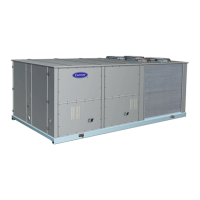
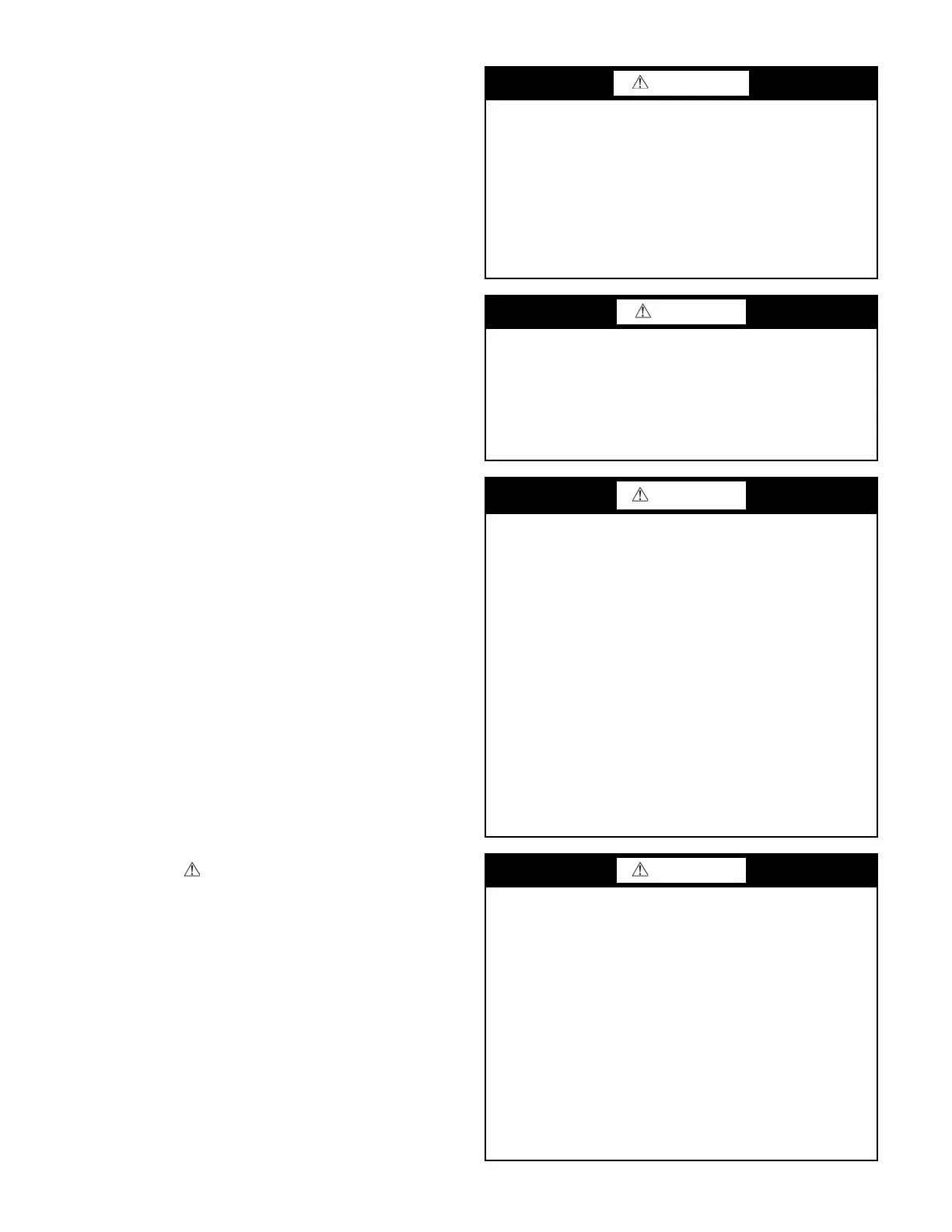